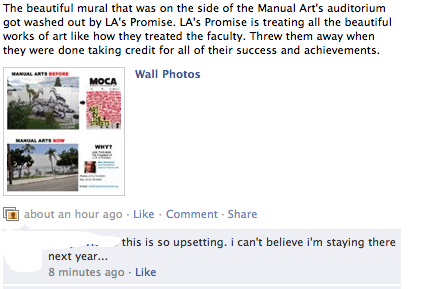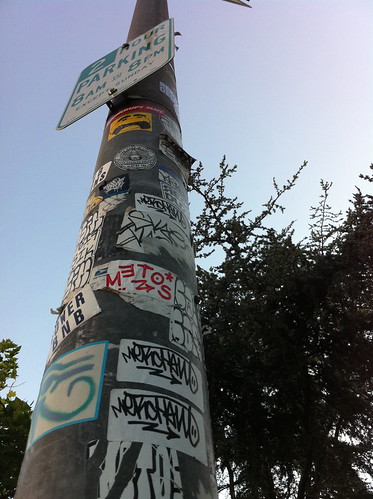[As should be obvious, the images and quoted text in this post were not made by me.]*

As schools are being cleaned, painted, prepared for the new year and as many of my friends collect unemployment and search for teaching jobs in charters and small non-LAUSD schools, I want to spend some time on this blog describing some of the individual challenges I’m seeing my school community face. I plan to dedicate several posts over the summer looking at what budget cuts and educational reform look like through the lens of my school. Starting right now.
The problem, of course, is that there isn’t even a pretense of objectivity in what I’m trying to do here. Pertaining specifically to the words and images here, I’m trying my best to simply offer you, the reader, a snapshot of what is happening. What I want to show now is how teachers are voicing, organizing, and enacting civic action within a public & open digital sphere.
“The Truth About L.A.’s Promise” Facebook group has only been up for about a day. I don’t know what kind of response the members can anticipate. As a bit of background, L.A.’s Promise is the “Network Partner” for Manual Arts; the company manages and oversees the organizational and academic operation of the school in conjunction with LAUSD. As I’ve written about before, the climate at the school over the past year has been less than harmonious. [If it sounds like I’m downplaying any conflict or tension, you would be absolutely correct; the focus here is on the Facebook group.]

Though I will weigh in at some point down the road, I want to simply show one way the current circumstances of public education are engaging teachers in responsive ways. The fact that many of the people, my friends & colleagues, who are voicing opinions in this digital space are no longer working at Manual Arts is not lost on me. Being liberated from this work environment allows for dissenting voice. However, for the teachers like myself that are still working at the school next year, I am interested in how this open Facebook group will protect and share support for teachers still teaching at Manual Arts and those that will not be teaching there in September.

![]()
Ultimately (and from the “safe” view of researcher), I am fascinated by the ways these teachers advocate and continue to “teach” within this space; former students speak up and participate in this group and the lessons of activism are seen by students – through what kind of interpretive lens is not up for me to decide.

Similarly, taking the traditionally text-heavy interface of groups, the participants of this open group are weaving images into a clearly digestible campaign.

Again, I have yet to see a response to this group. It’s membership and organization is still nascent. I am intrigued about the way Facebook’s process of recruitment – a current member simply “adds” me – signals to outsiders how I am to be read. Though I did not choose to join this group, I am automatically affiliated with them (and, conversely, I haven’t yet chosen to “leave” the group either).
Pragmatically, L.A.’s Promise could quickly scan the membership of this group, see that I am included, and see me as an individual that opposes them without engaging me in dialogue one way or another. I am essentially placed in an oppositional position simply through sharing digital space at the behest of a friend. Intrigued, I’m encouraging (but not “adding”) you to follow along.

*If you were to think that I was worried about retaliation or being seen as libelous, you would be correct.
[UPDATE: 7/29/11 12:21 a.m] This was posted by a member on the Facebook group:
Hey Everyone. Looks like I got REPORTED by someone on Facebook. Problem is I removed myself from “Admin” status when I started this group because I believed that it should be open to all.
I guess that’s how this group will be engaged for progressive dialogue.













